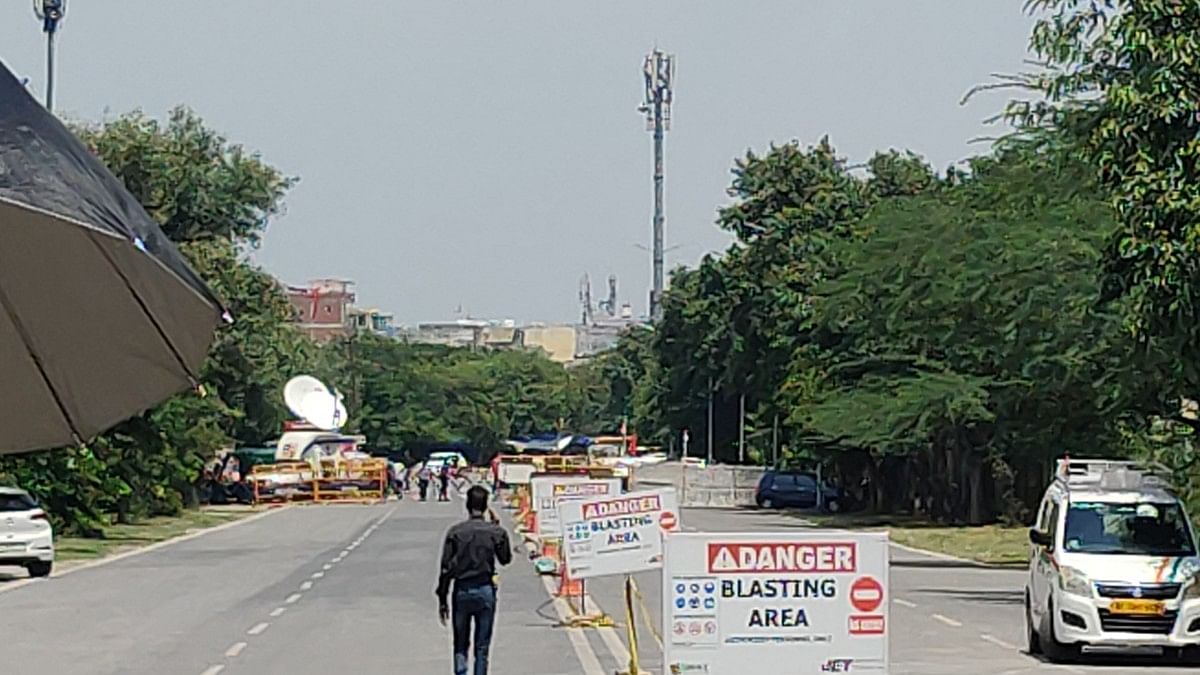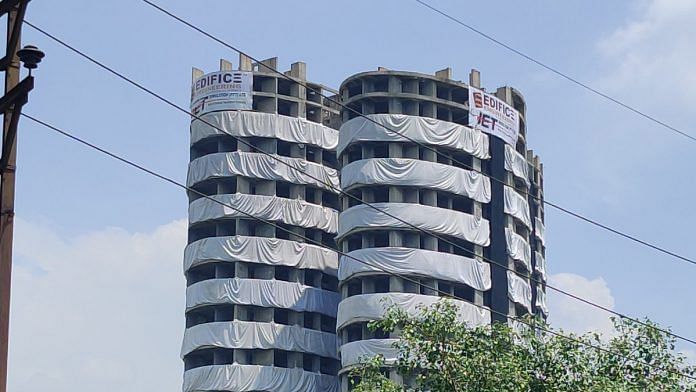New Delhi: 3,500 kilograms. That’s the quantity of explosives that authorities will need to tear down the 40-storey Supertech twin towers in Noida.
On 28 August — a year after the Supreme Court ordered the demolition of the illegal structure — authorities will bring down Apex and Cayene towers. Built by Supertech, the structures are to be demolished because of violations in building code.
The demolition is scheduled for 2.30 pm, and the entire process will be over in all of 15 seconds, Uttkarsh Mehta, a partner at Edifice Engineering, told ThePrint. “This is the tallest building in India that will be demolished through [a technique called] ‘building implosion’,” Mehta told ThePrint. It’ll take nine seconds for the demolition to initiate, and 4-6 more seconds for the structure to fall, he added.
Edifice Engineering had won the demolition contract in partnership with South Africa-based demolition specialist Jet Demolition in January.
The task is challenging as it has to be done without affecting nearby societies Emerald Court & ATS Green.
Hundreds of people and months of preparation — analysing the structure, deciding on the right explosives, conducting test blasts, and preparing for its aftermath — were involved in the overall task to bring down the towers which are taller than the Qutub Minar.
“There will be no problems. We have taken ample care so that nothing goes wrong in the two societies close by,” Mehta assured.
Also Read: How builders like Parsvnath sold ‘affordable’ homes dream and turned it into a nightmare
What is building implosion
Traditionally, engineers use a simpler method of tearing down buildings such as wrecking balls — huge suspended metal balls use to break down structures — or cranes with extended arms.
But in this case, the use of these methods pose challenges, mainly because the twin towers stand close to Emerald Court & ATS Green.
According to a research paper titled ‘Demolition of buildings by implosion’ , engineers opt for building implosion when there are structures around a building intended for demolition.
‘Building implosion’ is a controlled explosion that aims at forcing a building to collapse into itself — that is, straight down, without anything falling outwards or sideways.

The method is “considered when the building to be demolished is surrounded by structures that must be preserved”, the research paper says. “Demolishing the building in such a way that it collapses straight down into its own footprint (the total area at the base of the building),” it adds.
Simply put, implosion uses the force of gravity to help tear down a structure. Blasts are conducted on the lower floors to blow off the structural support. This demolition method tries to generate the maximum energy possible in order for the building to fall.
How it’s done
There’s no set pattern for this method and every structure needs a different type and quantity of explosives. It’s usually a pre-blast study, tests, and experience that help determine the method of demolition, said Mehta.
First, a structure is thoroughly studied using its blueprints and available information to determine the kind of explosives to be used.
According to the research paper, the most common explosives used in the process are “dynamites (straight, ammonia and gelatin), water gels, emulsions, PETN (penta-erythritol tetra- nitrate) and RDX (Cyclotrimethylene-trinitramine).”
Blasters — the people who carry out the blast — also need to make sure that the right quantity of explosives is being used. For this, test blasts are conducted.
“Test blast is for studies to understand the structure. We understand some bits from drawings. We do some core cuttings, take a test and understand the concrete reinforcements inside,” Mehta told ThePrint. “If needed, we do a test blast to understand if we put 1 kg of explosives, what is the amount of displacement. After that study was done, we changed a few things in our design.”
The next step is to remove unwanted columns that don’t carry the load of the building. This is done to remove any hindrance or unwanted resistance to the actual process. A successful explosion should throw the towers against each other, while all the rubble collects at the centre of the building.
“During a building implosion, the detonations are timed so that just before the alternate load path is created, the adjacent column line is detonated to allow continuity of the progressive failure (that is, the building falling from top to bottom),” the research paper says.
Timing is crucial, it adds, as even a second’s delay in the fall of columns can lead to the structure collapsing on either side instead of the intended straight direction.
Pressing the button
To ignite the explosives, a severe shock needs to be applied. A small number of explosives are attached to a blasting cap for this purpose. The blasting cap is a device that initiates the detonation of a “charge of a high explosive by subjecting it to percussion by a shock wave”.
Blasters light one end of the cord on this blasting cap to set off the explosives. This flame travels to the detonator on the other end and triggers the explosion. This process can also be done through an electronic wire with explosives at the detonator end.
Once the final checks are done, the trigger is pressed.
In case the implosion fails, authorities conduct the demolition manually. Although there have been instances where building implosions have failed, these are uncommon. One such case was reported in Dallas in February 2020 in which a failed implosion left an 11-storey building leaning sideways for days before it was finally brought down.
Precautions taken
As a precaution, Mehta told ThePrint, the company had the two towers covered with geotextile fabric, which is made of polypropylene or polyester, and placed impact cushions
at the buildings’ basements and on the society grounds.
The fabric is meant to trap any flying debris from the blast, said Mehta. The cushions absorb vibrations from the explosion.
The company has suggested that vibrations from the blast will be “less” than those felt in the past earthquakes in Noida, Mehta said. Vibration from the explosion will be one-tenth of such earthquakes, he claimed.
Mayur Mehta, a project manager at Edifice Engineering, admitted that there was a possibility of “minor damage” to the buildings nearby after the explosion. “(But) the only risk of damage is to the glasses of the buildings and nothing else,” he said.
(Edited by Uttara Ramaswamy)
Also Read: How Amrapali cheated 49,000 homebuyers, according to Supreme Court



